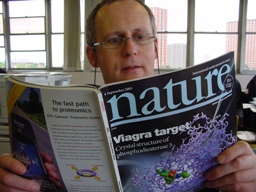 My graduation group photograph (1977) reveals a vanished world in which nearly all geology graduates were white and male (and not overweight). ‘Successful applicants to Geology’, it said in the Prospectus, ‘will be physically fit, able and willing to undertake strenuous fieldwork in all weather’. Subtext – the halt and lame can forget it.
My graduation group photograph (1977) reveals a vanished world in which nearly all geology graduates were white and male (and not overweight). ‘Successful applicants to Geology’, it said in the Prospectus, ‘will be physically fit, able and willing to undertake strenuous fieldwork in all weather’. Subtext – the halt and lame can forget it.
We were also not colour-blind, having been told on day one that that disability definitely debarred us from a successful career in geology, and they would find something else to do for anyone who owned up. The rest of us were forbidden to wear sunglasses on fieldwork, because they might interfere with the correct appreciation of colour.
It was nonsense of course; and one geology graduate, of that less selective institution the University of Oxford, has recounted the tale of how his own colour-blindness turned the Royal Navy’s loss into geology’s gain. His name – Simon Winchester FGS. Happily, these days are over, and the only acceptable policy is one that tries to include rather than exclude people.
Later, as a research student I organised my first scientific conference, and devised a questionnaire for registrants that, for the first time, asked about dietary and other special needs, including physical disability – though I recognised at the time that the question ‘Are you a wheelchair user?’ actually meant ‘Are you Howard Brunton?’. Nonetheless, all the venues I chose were selected with his possible participation in mind. In the end Howard stayed away; but that is not the point.
Having to think is trouble. But the effort is repaid, as our second feature this week - on the subject of designing accessible field activities - clearly demonstrates. And if the Society’s recent signature on the Science Council’s Declaration on Diversity, Equality and Inclusion (Soapbox, Geoscientist 24.11) is to mean more than a photo op and a certificate on the mantelpiece, we must ensure that we, and all schools, universities and those who teach in them, make that effort.
One person in that old student photo, however, suffered a condition that no amount of legislation could – or indeed perhaps should - assist. Never seen in lectures, sporadically on field trips, he was once knocked unconscious when his head was shunted between two stage-apron boxes, which he was helping porters to shift in the Student Union. He then tried (unsuccessfully) to sue the University for ‘brain damage’. Medics who examined him (just like the rest of us) found they were unable to tell whether his brain was damaged or not. He was just a white, fit, healthy, non-colour-blind idiot.
TED NIELD
Editor
@TedNield @geoscientistmag